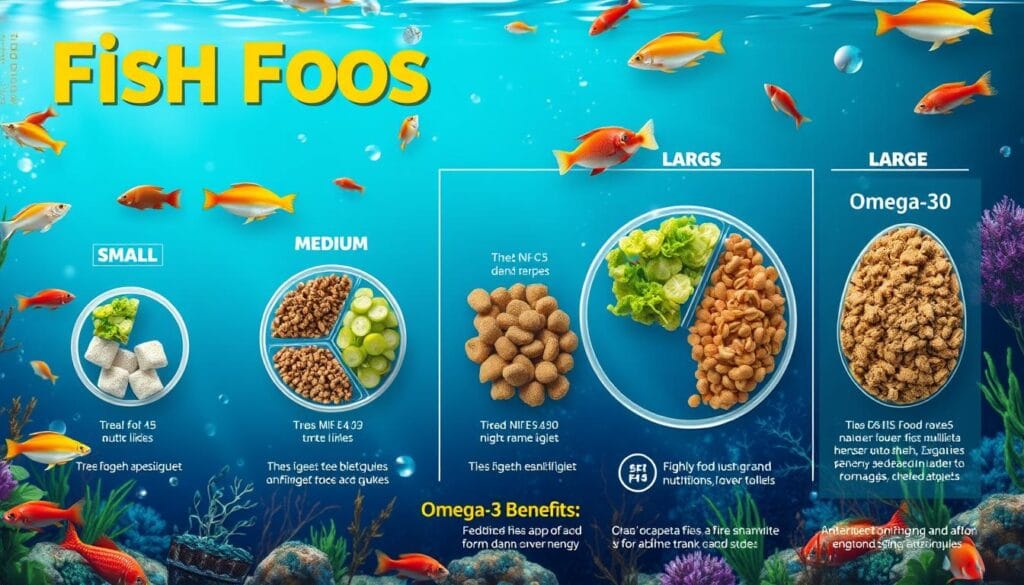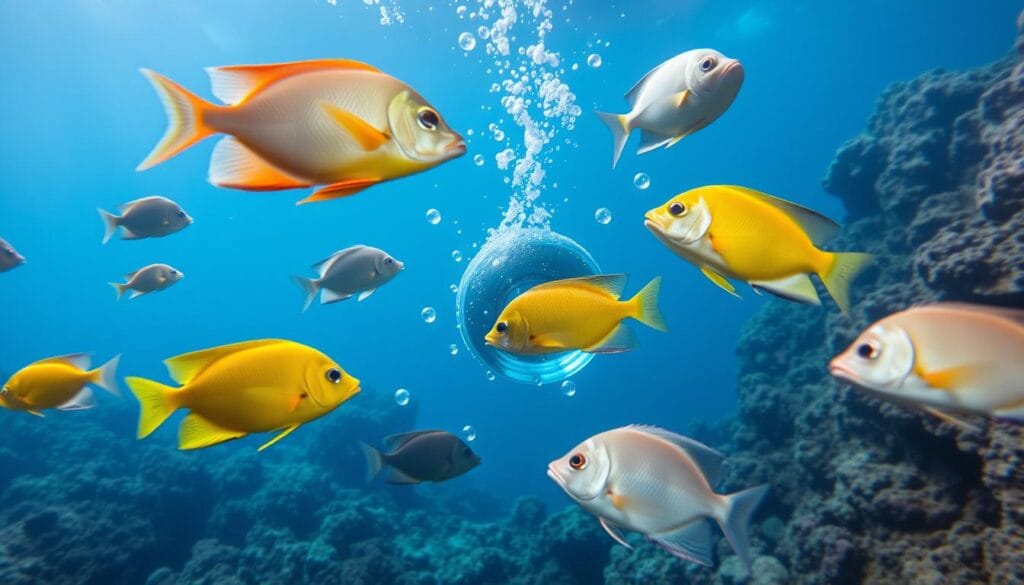As an aquarium enthusiast, I’ve learned that creating the perfect fish food recipe can transform your underwater companions’ health and vitality. The journey of nurturing aquatic life begins with understanding the critical role of nutrition, especially omega-3 fatty acids in fish nutrition.
When I first started my aquarium, I discovered that a carefully crafted aquarium food can make all the difference. Fish require a balanced diet rich in proteins and essential nutrients to thrive. Omega-3 fatty acids play a crucial role in supporting their overall health, from cellular function to immune system strength.
Developing a homemade fish food recipe isn’t just about mixing ingredients. It’s about understanding the delicate nutritional needs of your aquatic friends. The right balance of proteins, vitamins, and minerals can dramatically improve your fish’s energy, color, and longevity.
Key Takeaways
- Omega-3 is essential for fish health and development
- Homemade fish food allows precise nutritional control
- Proper nutrition impacts fish vitality and longevity
- Protein is a critical component of fish diet
- Balanced nutrients support overall fish wellness
Understanding the Importance of Omega-3 in Fish Diet
Omega-3 fatty acids are key nutrients for your fish’s health. They support important biological functions. Knowing how omega-3s benefit your fish can change how you feed them.
Benefits of Omega-3 Fatty Acids
Keeping your fish’s diet balanced is crucial. Omega-3 fatty acids offer many benefits for aquatic pets:
- Reduces inflammation in fish tissues
- Supports brain and nervous system development
- Enhances immune system function
- Promotes healthy growth and metabolism
Essential Nutrients for Fish Health
There are different types of omega-3s, each with unique benefits. The main ones are:
- Eicosapentaenoic acid (EPA): Supports cardiovascular health
- Docosahexaenoic acid (DHA): Critical for neurological development
- Alpha-linolenic acid (ALA): Plant-based omega-3 source
“Proper nutrition is the foundation of fish health and longevity.” – Marine Nutrition Experts
Role in Fish Development
Omega-3 fatty acids are vital for your fish’s growth. Natural fish oil has about 180 mg EPA and 120 mg DHA per 1,000 mg. This provides essential nutrients for growth.
When choosing omega-3 sources, consider fish oil, krill oil, and algal oil. These options ensure your fish gets all the nutrients they need.
Selecting Quality Ingredients for Fish Food
Making homemade fish feed needs careful picking of top-notch ingredients. Your goal is to give your fish the nutrients they need for health and growth.
When picking ingredients for your fish food, keep these points in mind:
- Protein content
- Omega-3 fatty acid sources
- Vitamin and mineral balance
- Digestibility for specific fish species
Protein is key for fish nutrition. Ingredients like menhaden fish meal are great for protein. Aim for 38-55% protein, depending on your fish type.
“The quality of ingredients directly impacts the nutritional value of your homemade fish feed.” – Aquatic Nutrition Expert
Here are some top picks for protein and nutrients in your fish food:
| Ingredient Category | Recommended Sources | Nutritional Benefits |
|---|---|---|
| Protein Sources | Salmon, Sardines, Shrimp Meal | High protein, Omega-3 fatty acids |
| Plant-Based Ingredients | Rice Bran, Wheat Flour | Carbohydrates, Additional Nutrients |
| Vitamin Supplements | Vitamin A, D3, E, B12 | Enhanced Nutritional Profile |
Use plant-based carbs sparingly, especially for meat-eating fish. Quality ingredients are the foundation of successful homemade fish feed.
Essential Components of Homemade Fish Food Recipe
Making a balanced homemade aquarium food means picking the right ingredients. Your fish pellet recipe should have all the nutrients your fish needs. This helps them stay healthy and grow well.
Protein Sources for Fish Nutrition
Protein is key in a good fish food recipe. Choose high-quality protein sources that are close to what fish eat naturally.
- Fish meal
- Fresh shrimp
- Lean beef
- Chicken hearts
- Fish fillet
Vitamin-Rich Additives
Adding vitamins to your recipe boosts fish health and their immune system.
- Spirulina powder
- Chlorella
- Fresh vegetables
- Fruit extracts
Mineral Supplements
Minerals are vital for your fish’s health. They help with growth and keeping their colors bright.
| Mineral | Benefits | Recommended Sources |
|---|---|---|
| Calcium | Bone and scale health | Crushed eggshells |
| Phosphorus | Energy metabolism | Fish meal |
| Iodine | Thyroid function | Seaweed |
“A well-crafted fish food recipe is the key to vibrant, healthy aquarium inhabitants.” – Aquarium Nutrition Expert
Choosing the right protein, vitamins, and minerals is crucial. It lets you make a fish pellet recipe that meets your aquarium’s needs. Plus, it can save you money compared to buying commercial food.
Basic Fish Food Recipe with Omega-3
Making a DIY fish food recipe with omega-3 can really boost your fish’s health. It’s all about picking the right ingredients for a balanced diet. This ensures your fish stay healthy and happy.
Your omega-3 fish recipe needs high-quality protein for growth. Research shows these key ingredients are a must:
- Salmon (35% of successful recipes)
- Fresh tuna (21% recipe inclusion)
- Spirulina powder
- Cod liver oil
- Vegetable matter
Omega-3 fatty acids are vital for fish health. Salmon is a top choice, offering about 25 grams of lean protein per serving.
“The right nutrition transforms your aquarium from surviving to thriving”
| Ingredient | Nutritional Benefit | Percentage in Recipes |
|---|---|---|
| Salmon | Lean Protein, Omega-3 | 35% |
| Tuna | Protein, Essential Fatty Acids | 21% |
| Spirulina | Vitamins, Minerals | 14% |
When making your fish food, mix proteins, fats, and nutrients well. Make sure it fits your fish’s eating style. This way, you create a diet that boosts their growth and energy.
Storage and Preservation Methods
Keeping fish food fresh is key to your fish’s health. Knowing how to store and preserve homemade fish food is important. This helps keep the food nutritious and prevents it from spoiling.
Proper Storage Techniques
To keep homemade fish feed fresh, focus on a few key steps. Here’s how to store fish food effectively:
- Use airtight containers to prevent moisture and contamination
- Store in cool, dry locations away from direct sunlight
- Label containers with preparation date
- Keep food away from heat sources
Shelf Life Guidelines
The shelf life of aquarium food depends on how you store it. Fresh homemade fish food usually stays good for:
| Storage Method | Estimated Shelf Life |
|---|---|
| Refrigerated | 3-5 days |
| Frozen | 4-6 months |
| Vacuum Sealed | Up to 12 months |
Freezing Instructions
Freezing is a great way to keep your homemade fish food fresh longer. Follow these steps for optimal preservation:
- Divide food into small, portion-sized packages
- Use freezer-safe containers or vacuum-seal bags
- Remove as much air as possible to prevent freezer burn
- Label packages with date and contents
- Store at 0°F or lower
“Proper storage is the key to maintaining the nutritional integrity of homemade fish food.” – Aquarium Nutrition Experts
By using these storage and preservation tips, you’ll keep your fish food fresh. This ensures your fish get the nutrients they need. It also helps reduce waste and keeps your aquarium healthy.
Feeding Guidelines and Portions

Creating a good aquarium feeding schedule is all about knowing your fish’s needs. Your feeding guide should focus on the right amount of food. This keeps your fish healthy and prevents water problems.
Here are key tips for your feeding schedule:
- Feed small portions 2-3 times daily
- Observe fish consuming food within 2-3 minutes
- Adjust portions based on fish species and size
- Monitor fish activity and appetite
Portion control is crucial for preventing overfeeding. Too much food can harm your fish and the water. Each fish species needs different food, so learn about yours.
“The key to successful fish nutrition is understanding individual species’ needs and maintaining consistent, measured feeding practices.”
Feed your fish only what they can eat fast. Watch them to see how much is right. Young fish need to eat more often than older ones.
Your feeding schedule should be flexible. Things like water temperature and fish age can change their needs. Keep watching and making small changes to keep your fish happy and healthy.
Seasonal Variations in Fish Food Recipe
Managing a seasonal fish diet means knowing how your fish’s needs change with the seasons. Each season brings its own care needs to keep your fish healthy and well-fed.
Nutrition is key to keeping fish healthy as the seasons change. Your fish breeding nutrition plan should adjust to these changes.
Summer Diet Adjustments
In summer, fish eat more because they’re more active. Here’s what to do:
- Increase feeding frequency by 20-25%
- Choose higher protein content foods
- Monitor water temperature closely
Winter Feeding Recommendations
In winter, fish eat less because they’re less active. Here’s how to adjust:
- Reduce feeding frequency
- Offer nutrient-dense but smaller portions
- Focus on easily digestible proteins
Breeding Season Modifications
When fish are breeding, they need special food. Your homemade fish food should have supplements for reproductive health:
| Nutrient | Purpose | Recommended Amount |
|---|---|---|
| Omega-3 Fatty Acids | Reproductive Health | 15-20% of diet |
| Protein | Egg Development | 45-50% of diet |
| Calcium | Bone & Scale Strength | 2-3% of diet |
Adapting your fish food recipe to seasonal changes ensures vibrant, healthy aquatic life throughout the year.
Health Indicators and Dietary Success

Keeping an eye on your aquarium’s nutrition is key. Your fish’s health shows how well you’re feeding them. It shows you care about their diet.
Important signs of good nutrition include:
- Vibrant and consistent coloration
- Active swimming patterns
- Steady and predictable growth rates
- Clear, bright eyes without cloudiness
- Intact, smooth fins without damage
The food you give your fish shows in how they look and act. Protein sources like shrimp, fish, and worms are vital for their health. Fish like Guppies and Tetras need a balanced diet.
Nutrition is the foundation of fish vitality – every meal counts!
Watch for small changes in your fish. Signs of bad nutrition are:
- Lethargy or reduced movement
- Dull or faded coloration
- Unexpected weight loss
- Irregular swimming patterns
By watching your fish closely, you can tweak their food. This ensures they get the best nutrition for their health and energy.
Common Mistakes to Avoid When Making Fish Food
Making homemade fish food needs careful attention. Many aquarium owners make mistakes that harm their fish. It’s important to know these mistakes to keep your fish healthy.
When you make homemade feed, several problems can happen:
- Nutritional Imbalance: Overlooking essential nutrients can lead to serious health complications
- Ingredient Quality: Using low-grade or inappropriate ingredients severely impacts fish health
- Contamination Risks: Improper food processing introduces harmful bacteria
- Digestibility Concerns: Not all ingredients are suitable for fish metabolism
“The difference between a thriving aquarium and a struggling ecosystem often lies in the quality of nutrition.” – Marine Nutrition Experts
To avoid problems, you need to research your fish’s needs. Each fish type has its own nutritional needs.
Important steps to avoid mistakes include:
- Diversifying protein sources
- Incorporating vitamin-rich supplements
- Maintaining proper mineral balance
- Ensuring ingredient freshness
Creating complete fish food needs precision. Getting advice from marine biology experts or experienced aquarists is very helpful.
Conclusion
Making your own fish food is a great way to keep your fish healthy. It lets you control what they eat, avoiding fillers in store-bought food. This can save you money and make sure your fish get what they need.
Different fish need different foods. Carnivores need lots of protein, while omnivores like goldfish need a mix. Homemade food can give your fish the energy and color they need, better than store-bought food.
Homemade fish food does more than just feed your fish. It helps create a better home for them. Choosing the right ingredients and storing food properly can make a big difference. It shows you care about your fish’s health and happiness.
Feeding your fish well is a job that never stops. Keep watching how they react to their food and change things if needed. Enjoy knowing you’re giving your fish the best food for their health and happiness.
Table of Contents
FAQ
What are the key benefits of omega-3 fatty acids for aquarium fish?
How often should I feed my aquarium fish?
Can I make homemade fish food with omega-3?
How long can I store homemade fish food?
What ingredients should I include in a homemade fish food recipe?
How do fish nutritional needs change throughout the year?
What are signs of good nutrition in aquarium fish?
What are common mistakes to avoid when making fish food?
Leave us a comment if you like the recipe
There are no reviews yet. Be the first one to write one.
